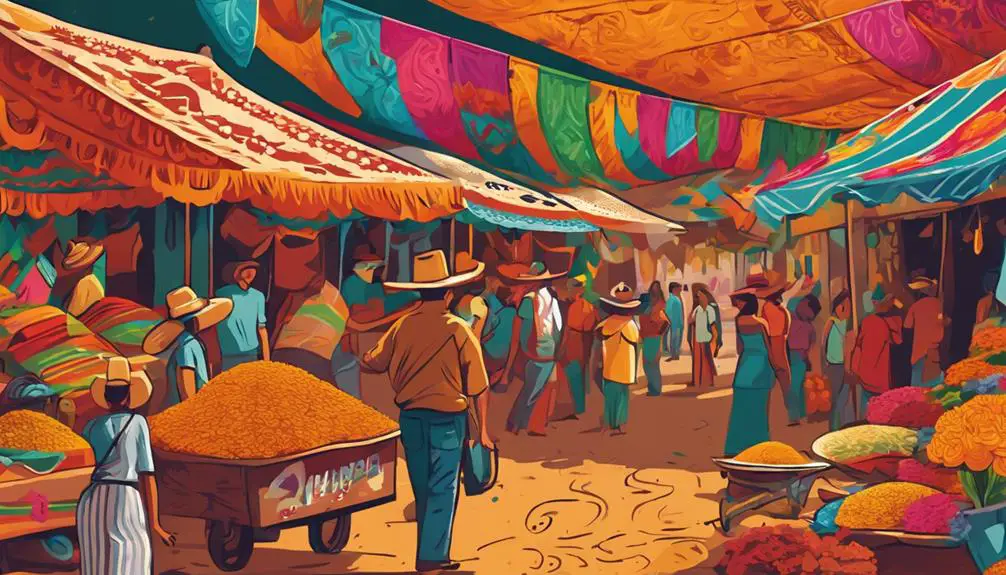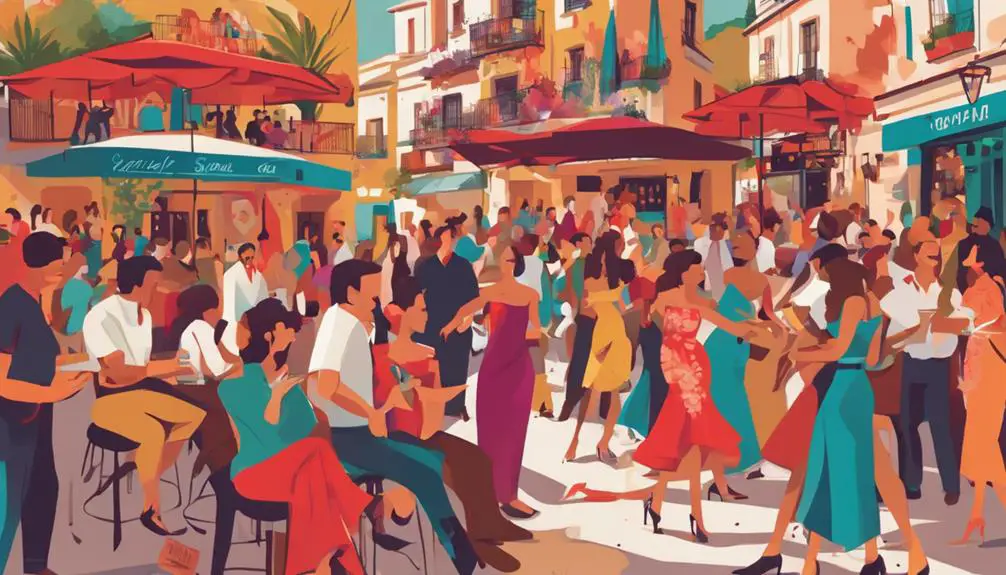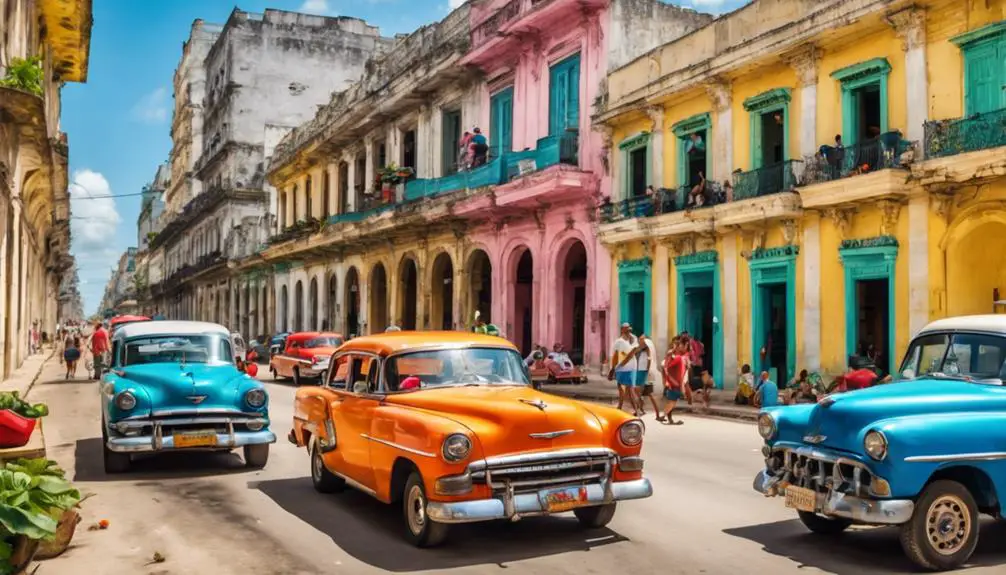You'll encounter various ways to ask 'how much' in Spanish, depending on the region. In Mexico, ¡Cuánto? is the go-to phrase, but Central America has its own twists, like ¡Cuánto cuesta? in Costa Rica or ¡Cuánto sale? in Nicaragua. In Spain, slang is influenced by regional dialects and youth culture. In South America, ¡Cuánto cuesta? is common, but Chile, Argentina, and Uruguay prefer ¡Cuánto vale?. You'll master the nuances of each region, and as you explore further, you'll discover the intricacies of Cuban colloquial expressions and much more.
Mexican Spanish: Cuánto?

In Mexican Spanish, the phrase '¿Cuánto?' is a common way to ask 'How much?' or 'How many?' when inquiring about prices, quantities, or frequencies.
When exploring Mexican dialects, understanding this phrase is essential for effective communication in everyday situations.
You'll find that '¿Cuánto?' is frequently used in markets, shops, and restaurants to ask about prices or quantities of items.
For instance, if you're at a local market and want to know the price of a souvenir, you can ask the vendor '¿Cuánto cuesta?' (How much does it cost?).
Similarly, if you're at a restaurant and want to know how many dishes are available, you can ask '¿Cuántos platos hay?' (How many dishes are there?).
Mastering this phrase will help you handle everyday situations with confidence.
Central American Variations
Understanding the distinct variations of Spanish slang in Central America is crucial, where countries like Costa Rica, Nicaragua, and Panama each have their unique flavor of expressions and idioms. As you explore the region, you'll notice that each country has its own way of expressing prices and negotiating deals.
| Country | Slang Expression |
|---|---|
| Costa Rica | '¿Cuánto cuesta?' (How much does it cost?) – often used to inquire about Costa Rican pricing. |
| Nicaragua | '¿Cuánto sale?' (How much does it come out to?) – commonly used to ask for the final price, especially when looking for Nicaraguan bargains. |
| Panama | '¿Cuánto te doy?' (How much do I give you?) – a phrase used to negotiate prices, especially at markets or from street vendors. |
When communicating with locals, using these expressions will help you better grasp the culture and secure a better deal. Remember, each country has its own nuances, so being aware of these variations is crucial to avoid misunderstandings and make the most of your interactions. By incorporating these expressions into your vocabulary, you'll be able to navigate the complexities of Central American pricing with confidence.
Spanish Slang in Spain

As you shift your focus from Central America to the Iberian Peninsula, Spain's unique brand of Spanish slang awaits, shaped by the country's rich cultural heritage and history.
You'll notice that regional dialects play a significant role in shaping the slang used in different parts of the country. For instance, the Andalusian dialect, spoken in the southern region of Andalusia, has a distinct flavor influenced by the region's Moorish past.
In contrast, the dialect spoken in the northern region of Catalonia is heavily influenced by Catalan, a language closely related to Spanish.
Youth culture also has a significant impact on Spanish slang in Spain. Young people, particularly in urban centers like Madrid and Barcelona, are driving the evolution of slang through social media, music, and street art. You'll hear terms like 'guay' (cool) and 'chulo' (awesome) being used to express enthusiasm or approval.
Additionally, the influence of immigration and globalization has introduced new words and phrases into the Spanish slang lexicon, further enriching the country's linguistic diversity.
As you delve deeper into Spanish slang in Spain, you'll discover a rich tapestry of regional dialects, youth culture, and cultural exchange.
How Much in South America
Your travels take you to South America, where the nuances of Spanish slang vary greatly from country to country, and understanding how to ask 'how much' in each region is important for getting around local markets and negotiating prices.
In the Andean region, you'll want to ask '¿Cuánto cuesta?' to get an accurate idea of Andean pricing. This phrase is widely used in countries like Peru, Bolivia, and Ecuador.
Meanwhile, in the Amazonian regions of Brazil, Colombia, and Ecuador, you'll hear 'Quanto custa?' being used to inquire about Amazonian costs.
In Chile, Argentina, and Uruguay, you'll use '¿Cuánto vale?' to ask about prices. This phrase is also commonly used in Paraguay and parts of Bolivia.
Keep in mind that some countries, like Venezuela and Guyana, use '¿Cuánto es?' to ask about prices. Understanding these regional differences will help you navigate marketplaces and negotiate prices like a local.
Colloquial Expressions in Cuba

In Cuba, colloquial expressions are woven into everyday conversations, and mastering a few essential phrases will help you navigate the vibrant streets of Havana and beyond. You'll quickly notice that Cubans use idiomatic expressions to reveal a more authentic experience in Cuba.
For instance, '¡Estar la mar de…' (to be extremely) is a common way to emphasize a feeling or situation. You might hear a local say, 'Estoy la mar de cansado' (I'm extremely tired). Another popular phrase is 'Tomar el pelo' (to take someone's hair), which means to tease or joke with someone.
Familiarizing yourself with Havana phrases like these will help you connect with the locals and appreciate the island's unique culture. You might even find yourself adopting some Cuban idioms into your own language. Don't be afraid to ask your Cuban friends to teach you more phrases, and you'll soon be speaking like a native.
Regional Nuances in Latin America
Across Latin America, you'll encounter distinct regional nuances that flavor local dialects, making each country's slang unique. As you explore the region, you'll notice that cultural, historical, and geographical factors have shaped the language, resulting in diverse slang expressions.
In the Andean region, you'll find Quechua influences in countries like Peru, Bolivia, and Ecuador. The indigenous dialects have blended with Spanish, creating distinct slang expressions. For instance, in Peru, 'chibolo' means 'friend,' while in Bolivia, 'ch'alla' is used to express appreciation.
In contrast, Caribbean countries like Puerto Rico, Dominican Republic, and Cuba have been influenced by African rhythms and European colonization. You'll hear Caribbean influences in the slang, with a focus on musicality and rhythm. In Puerto Rico, 'guagua' means 'bus,' while in the Dominican Republic, 'guapo' is used to describe something cool.
Understanding these regional nuances is essential to mastering Spanish slang. By recognizing the cultural and historical contexts, you'll be better equipped to navigate the diverse linguistic landscape of Latin America.
Frequently Asked Questions
Is "Cuánto" Used in All Spanish-Speaking Countries?
You're wondering if 'cuánto' is universally used in all Spanish-speaking countries. The answer lies in country variations and dialect differences.
While 'cuánto' is the standard way to ask 'how much' in Spanish, some countries have their own twists. In Argentina, Uruguay, and Paraguay, you might hear 'cuánta plata' instead. In Colombia, 'cuánto vale' is common.
Be prepared for these nuances to enhance your communication when interacting with native speakers from different regions.
Are There Regional Differences in Counting Money?
When you venture into the world of counting money, you'll notice regional differences in dialects. You'll find that money dialects vary across Spanish-speaking countries, with distinct regional variations.
In some countries, like Argentina, you'll hear 'luca' for 1,000 pesos, while in others, like Mexico, 'varos' means pesos. You'll need to adapt to local money dialects to navigate everyday transactions accurately.
Can I Use "Cuánto" for Time and Distance Too?
When exploring unfamiliar terrain, you'll often find yourself lost in translation. Literally.
Can you use 'cuánto' for time and distance? Yes, you can.
For time phrases, 'cuánto tiempo' means 'how much time' or 'how long.'
For distance measurements, 'cuántos kilómetros' means 'how many kilometers.'
Mastering these phrases will help you gauge your journey, whether it's the duration of a bus ride or the distance to your next destination.
How Do I Respond to "¿Cuánto Cuesta?" in a Store?
When a store clerk asks '¿Cuánto cuesta?' (how much does it cost?), you're expected to respond with the price or a negotiated offer. Maintain good store etiquette by being respectful and polite.
If you're unsure about the price, ask '¿Cuánto cuesta exactamente?' (how much does it exactly cost?).
Don't be afraid to negotiate the price, especially at smaller shops or markets. Remember to stay calm and courteous, as price negotiation is a common practice in many cultures.
Is "Cuánto" Used in Formal and Informal Settings Equally?
You're about to uncover a surprising truth about the versatility of 'cuánto'. While you might think it's only used in casual conversations, you'll be surprised to know that 'cuánto' is equally at home in formal and informal settings.
Whether you're negotiating a deal in a boardroom or chatting with friends at a café, 'cuánto' seamlessly adapts to the tone, maintaining a formal tone in professional settings and a casual vibe in everyday conversations.
Conclusion
As you explore the diverse landscapes of Spanish-speaking countries, you're still left wondering: how much in Spanish slang? The answers linger, waiting to be uncovered.
From Mexico's 'cuánto' to Spain's '¿cuánto cuesta?', each region whispers its own secrets.
Cuba's '¿cuánto es?' echoes through the streets, while South America's '¿cuánto vale?' beckons.
The nuances of Latin America remain, waiting to be deciphered. Will you crack the code and unravel the mysteries of 'how much' in Spanish slang?







